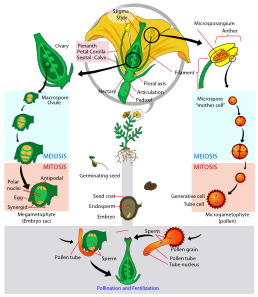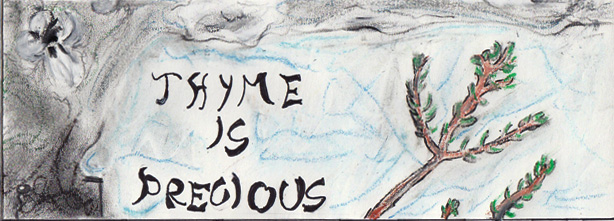Reproduction
How does Thymus vulgaris reproduce?
To figure out thyme's life cycle, you need to know how it is
classified. Thymus vulgaris is a plant; all plants have
alternation of generations. This
means there is a multicellular diploid and haploid. It is also
an angiosperm. The
life cycle of flowering plant is a shown below.
 Angiosperms like other vascular plants have a dominant
sporophyte lifecycle. The cycle starts when microspores divide
by mitosis to form pollen, which is housed in the anthers. The
macrospore in the ovule will become the seed. A pollinator comes
along and picks up pollen from that flower, and if carried to a
flower of the same species, will pollinate that flower. When a
flower is fertilized, pollen travels throughout the pollen tube
to fertilize the ovule. This process must happen twice in order
make a seed. After the double fertilization, the zygote and
endosperm develop. The endosperm is the food source for the
seed. When conditions are right, the seed will germinate. After
germination, the seed will grow into a mature sporophyte and
repeat the cycle
Angiosperms like other vascular plants have a dominant
sporophyte lifecycle. The cycle starts when microspores divide
by mitosis to form pollen, which is housed in the anthers. The
macrospore in the ovule will become the seed. A pollinator comes
along and picks up pollen from that flower, and if carried to a
flower of the same species, will pollinate that flower. When a
flower is fertilized, pollen travels throughout the pollen tube
to fertilize the ovule. This process must happen twice in order
make a seed. After the double fertilization, the zygote and
endosperm develop. The endosperm is the food source for the
seed. When conditions are right, the seed will germinate. After
germination, the seed will grow into a mature sporophyte and
repeat the cycle
Thyme vulgaris can be a hermaphrodite, male and female, or
diecious, male or female. This sounds strange to us, but
hermaphrodites are common in many plant and invertebrates
species. While I was researching an anomaly came up, Thymus vulgaris tends to be female or hermaphroditic. Why would there
not be male plants? In some cases, they are completely absent
and if present, sterility is a problem. No one is really sure
why. The females can produce seeds to colonize new areas; they
may be favored. But if this is the case, hermaphrodites can
produce seeds as well. Why would they not be favored? For female
plants to coexist with hermaphrodite, they must produce more
seeds. This balance in this gynodioecy, a community of female
and hermaphrodite plants coexisting, is still a mystery to
scientists today.
